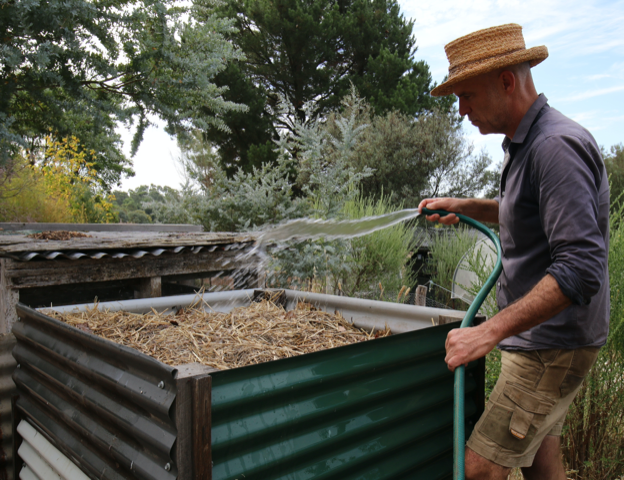In last-week’s Compost Conversation we looked at what makes some batches of compost go over temperature (over 68o Celsius), and why that is a problem. This week we’ll look at the remedies. The suggestions made in this article could be detrimental to a compost not suffering overheat, so please read this week’s and last week’s articles together.
But first, a reminder. Composts get too hot as a result of not being dense enough. Low density composts, with lots of airy, carbon-rich materials, are prone to overheating, poor at holding water and highly susceptible to drying out.
The first remedial action for an over temperature pile is to add water. Giving our pile a good soak will usually bring the temperature down, partly because the water will be cooler than the pile, but mostly because water adds so much mass, or density to the pile.
One hundred litres of water weighs 100kg, and that is a lot of mass to bring back up to 68o+.
Keep in mind that a dry pile might have become hydrophobic, leading to water just leaking out through the pile as we try to wet it, so allow time for water to slowly soak into the compost.
The next two remedial actions we’ll discuss should only be used in the case of overheating, always with a good soaking of water first and with close observations of the impact.
Holes, or chimneys can be punched in the pile with a garden stake, spaced approximately 30cm apart. Drive the stake deep into the pile and rotate it around before removing it. This will let out some of the extra heat and allow extra oxygen in, but can also exacerbate drying. A gentle water after you have made these chimneys helps get water deep into the pile.
If we know our overheating compost is due to excessive air space, we can compress the pile a little, reducing the insulation and increasing the mass of the pile. Care is needed, as compression can exacerbate anaerobic conditions. It is best to underdo it, and watch what happens over the first 12 – 24 hours. We can always do a bit more if needed, but over compression will require a good compost screw aeration, or a full turn.
The longer-term solution will always be in adjusting our compost recipe. Consistently over temperature composts need more density in our recipe. Lean harder on those heavier materials; wet manures, coffee grounds (great at adding density to a pile), and clay-rich soils (sprinkled lightly between layers).
Even selecting heavier, denser variants of our favourite carbon-rich ingredients will help, like well-rotted wood chips, finer, more broken-down autumn leaves and less coarse straw.
All these will add their own density to the pile as well as being better at holding on to water, with the moisture adding to the density and mass of the pile.
We still need good aeration through our pile, so take care not to go too far the other way.
— Joel Meadows works with *Yes In My Back Yard, (YIMBY), a community-scale composting initiative in Castlemaine and surrounds. Send questions or comments to hello@yimbycompost.com, or to book in for a compost workshop.








